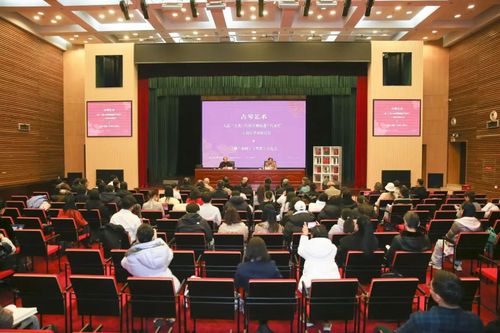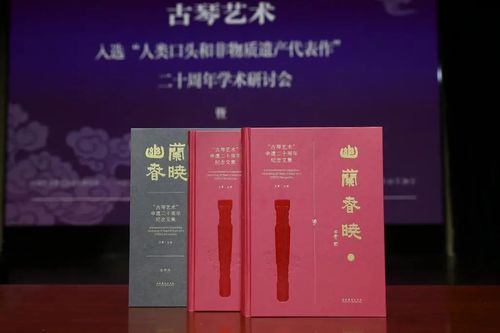Academic discussion Guqin art to protect the harmonists and promote the development and inheritance of qin learning
The year 2023 marks the 20th anniversary of the adoption of the Convention for the Safeguarding of the Intangible Cultural Heritage and the 20th anniversary of the selection of Guqin art in the second batch of UNESCO Masterpieces of the Oral and Intangible Heritage of Humanity. On November 28, 2023, the Academic seminar on the 20th anniversary of the selection of Guqin art in the second batch of UNESCO Masterpieces of the Oral and Intangible Heritage of Humanity and the inaugural ceremony of "Orchis Chunxiao" and "Qin Hui" jointly organized by the Institute of Music of the Chinese National Academy of Arts, the China Kunqu Opera Guqin Research Institute and the Culture and Art Publishing House were held at the Chinese National Academy of Arts. Wang Chenyang, Director of the Intangible Cultural Heritage Department of the Ministry of Culture and Tourism; Wang Fuzhou, Vice President of the Chinese National Academy of Arts and Director of the China Intangible Cultural Heritage Protection Center; Yu Jing, Vice President of the Chinese National Academy of Arts and Director of the Chinese Cultural Research Institute; Tian Qing, Honorary Director of the Music Research Institute of the Chinese National Academy of Arts and honorary President of the Chinese Kunqu Opera Guqin Research Institute; Xu Fushan, President of Culture and Art Publishing House, attended the meeting and delivered a speech. Li Hongfeng, director of the Music Research Institute of the Chinese National Academy of Arts, presided over the opening ceremony.

At the opening ceremony, Wang Chenyang summarized and affirmed a series of effective work carried out by the Chinese National Academy of Arts on the protection of guqin art, and thanked several generations of qin scholars for their positive contributions to the protection and inheritance of guqin. He proposed that we should continue to dig into the form characteristics of Guqin art, the humanistic spirit and value concept contained in it, further promote the characteristics of Chinese civilization possessed by Guqin art, integrate cultural confidence into the spiritual purinterests and cultural character of the whole nation, and then promote the construction of the value system and aesthetic system of the modern civilization of the Chinese nation, continue the historical context, and write a contemporary chapter. Wang Fuzhou put forward several suggestions on how to fulfill the duties of Guqin representative inheritors, protection units and social groups: first, strengthen project protection, second, strengthen support for inheritors, and third, encourage public participation. Yu Jing introduced in detail the series of work done by the Chinese National Academy of Arts in the rescue, protection and inheritance of Guqin art, pointing out that Guqin is the gene of Chinese culture, the model of Chinese spirit, the code of Chinese civilization and the belief of the Chinese nation. To build the modern civilization of the Chinese nation, we need to return to the continuous tradition, return to the consistent music of the qin, and protect the ancient "qin" from the source of civilization with the consistent "new". Xu Fushan briefly introduced the publishing situation and main contents of two works, "Youlan Chunxiao -- Collection of Essays on the 20th Anniversary of the application of Guqin Art" and "Qin Hui". Among them, "Youlan Chunxiao" selected the representative academic papers in the field of guqin art since 2003, covering ten aspects such as qin theory, qin history, Qin people and Qin music. "Qin Hui" consists of five volumes, including 61 pieces of qin music performed by Xia Yifeng, Ling Qizhen and Xie Xiaoping, which were recorded and sorted out by Mr. Yang Yinliu during his four years in Nanjing. The publication of these two works is an important achievement since the development of Guqin art protection, hoping to provide an important reference for the study of Guqin.

This conference consists of two parts: academic seminar and piano expert exhibition. At the academic seminar, 12 piano players and scholars, including Chen Changlin, Wu Zhao, Li Xiangting, Ding Chengyun, Qin Xu, Zhao Jiazhen, Dai Xiaolian, Wang Peng, Wang Feng, Yang Chunwei, Lin Chen and Li Cun, made speeches successively, reviewing the development history of Guqin art, summarizing the conservation achievements in the past 20 years, and from the perspective of artistic form, inheritance characteristics and cultural ecology of Guqin art. To explore the artistic value and humanistic spirit contained in Guqin art, as well as the concepts and methods of protection work in different periods, and constantly promote the protection, inheritance and promotion of Guqin art. Xue Yibing, a researcher at the Music Research Institute of the Chinese National Academy of Arts, made a summary comment on the academic seminar.
Chen Changlin, Wu Zhao, Li Xiangting, Ding Chengyun, Zhao Jiazhen, Dai Xiaolian, Wang Peng, Lin Chen, Li Cun and other 9 pianists were invited to perform live, aiming to exchange the achievements of Guqin learning, promote the development of Guqin learning, enhance public appreciation of Guqin art, and promote the academic community to think deeply about the protection and inheritance of Guqin art.
In the 1950s, the Institute of Music of the Chinese National Academy of Arts conducted the first nationwide survey of guqin, which had an important impact on the protection, inheritance and research of guqin art, and laid the foundation for the rich collection of guqin studies of the Chinese National Academy of Arts. Since the Guqin art was included in the second batch of UNESCO Masterpieces of the Oral and Intangible Heritage of Humanity, the Guqin art has ushered in unprecedented prosperity. As the declaration and protection unit of guqin art, the Chinese National Academy of Arts, together with the China Kunqu Opera Guqin Research Association, local qin clubs and qin players, jointly carry out various forms of public welfare activities such as the guqin art into the campus, into the community, through performances, lectures, exhibitions and other forms, so that the guqin art has been fully popularized in the whole society. A series of activities such as "Guqin into the university", "Handing over the heritage to the future - Kunqu Guqin famous music into 100 schools", "Beautiful scenery, Prince Gong's House intangible cultural Heritage performance season", "Taishan Beidou reflecting the blue Sky - Guqin famous concert" have formed a brand effect and played an important role in promoting the promotion of Guqin art. Since 2003, the Music Research Institute of the Chinese National Academy of Arts, the China Kunqu Opera Guqin Research Institute and other institutions have held more than 50 academic seminars and music recording sessions on guqin, and published more than 100 books on guqin art and thousands of academic papers. These achievements have created history while excavating tradition and summing up history, and become a heavy chapter in the development history of Guqin art.
Guqin art is not only an important part of traditional Chinese music, but also the common cultural heritage and spiritual wealth of mankind. Mr. Tian Qing said in his speech that there are three main reasons for the development of Guqin art from the brink of extinction to unprecedented prosperity in 20 years: First, the excellent traditional Chinese culture represented by Guqin art has vitality and infinite charm; Second, the country's strong advocacy of traditional culture and China's great achievements in economic construction; Third, the protection of intangible cultural heritage and the protection of cultural diversity have formed a social consensus, and the Guqin art has met new opportunities after the successful application.
The Chinese National Academy of Arts is a UNESCO representative project of the intangible cultural heritage of humanity Guqin art application and protection unit, is also a national project protection unit. For a long time, the Institute of Music of the Chinese National Academy of Arts, relying on strong academic resources and rigorous protection concepts, has followed the law of the development of guqin art and accumulated rich results in the study of guqin. The successful holding of this conference will further promote the protection of guqin art, and play a leading role in the inheritance and promotion of guqin art and the research of guqin.
 渝公网安备 50010702504639号
渝公网安备 50010702504639号